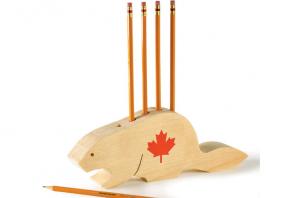
The beaver is a Canadian icon, largely because 19th-century Europeans took a fancy to beaver-pelt hats. Lucky for us-and the beaver-fashion is fickle and furry hats were replaced with other materials. The beaver finally attained official status as an emblem of Canada in 1975. So in honour of this great national icon, why not build this pencil caddy for your desk? It’s a great project for beginners and it’s simple enough to make with your kids.
The hardest part of this project is getting the beaver outline onto your piece of wood. Enlarge the plan to actual size using a photocopier (about 250 per cent), then fasten the pattern to your wood blank using spray adhesive or brush-on rubber cement. Position the pattern so its flat bottom is flush with the edge of your wood, allowing the pencil caddy to sit flat on your desk. Next, use a scrollsaw or bandsaw fitted with a 1/8"-wide blade to cut around the perimeter of the beaver. Proceed slowly when cutting and try to stay about a pencil-line width on the waste side of the pattern.
Next, sand the edges of the beaver, by hand or with a spindle sander if you have access to one. Measure and mark the pencil holes on the top, then drill using a 5/16"-dia. bit chucked in a drillpress. Make the holes end at the same depth so that the tops of the pencils line up (see plans). Switch to a 3/16"-dia. bit and drill a couple of holes for the eyes. Add the maple leaf to the side of the caddy using another copy of the pattern as a stencil. Cut out the maple leaf using an Exacto knife and spray or dab some red paint through the stencil. Finish the caddy with two coats of polyurethane, and you're done.
| Part | Material | Size (T x W x L*) | Qty. |
|---|
| Pencil caddy | pine | 2 x 6 | 12" |
* Length indicates grain direction
Scrollsaw
Drillpress fitted with 5/16
No comments
To leave a comment, please log in
Don't have an user account? Register for free